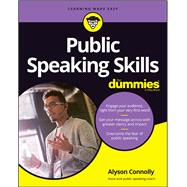Project self-assurance when speaking—even if you don't feel confident!
When you speak in public, your reputation is at stake. Whether you're speaking at a conference, pitching for new business, or presenting to your Executive Board, the ability to connect with, influence, and inspire your audience is a critically important skill. Public Speaking Skills For Dummies introduces you to simple, practical, and real-world techniques and insights that will transform your ability to achieve impact through the spoken word.
In this book, champion of public speaking Alyson Connolly takes you step by step through the process of conceiving, crafting, and delivering a high-impact presentation. You’ll discover how to overcome your nerves, engage your audience, and convey gravitas—all while getting your message across clearly and concisely.
• Bring ideas to life through business storytelling
• Use space and achieve an even greater sense of poise
• Get your message across with greater clarity, concision, and impact
• Deal more effectively with awkward questions
Get ready to win over hearts and minds —and deliver the talk of your life!








